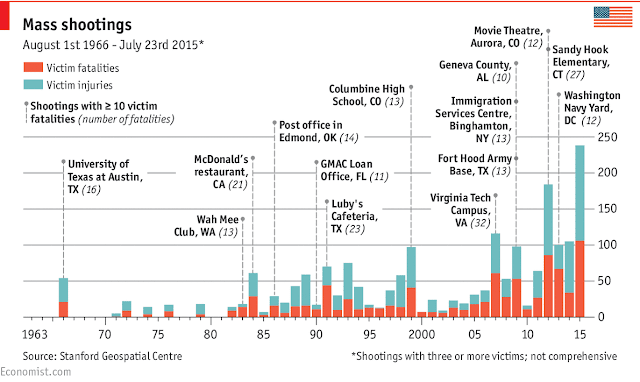WITH one of the highest murder rates among OECD countries—second only to Mexico—America retains its reputation as a disproportionately dangerous country. The number of violent assaults in America is comparable to those of other western countries, yet murders are much more common. The prevalence of guns goes a long way toward explaining America's terrible record—they are used in two-thirds of all murders. Americans are five times as likely to be murdered as Brits but over 40 times as likely to be murdered with a gun.
INTERACTIVE: ”The means to an end”, American gun ownership and suicide rates America has become a much safer place over the past two decades however, but public sentiment has yet to catch on to the fact. In 1993, near the peak of America's crime wave, 7 out of every 100,000 people aged 12 and up were gunned down. That number has since halved. But guns play a large role in suicides too. In 2013, 21,175 Americans killed themselves with guns, while 11,208 were killed by others. Men are four times as likely to kill themselves despite making fewer attempts, in no small part because their preferred method (guns) of suicide is so much more reliable than the alternatives. The rate at which people kill themselves with guns has increased since 2006.
There is no national database of gun ownership, because the gun lobby sees that as a first step towards disarmament. The number of guns in America therefore has to be inferred from survey data, commercial records and background checks. None of these measures are perfect: a gun owner may not necessarily need a background check if he or she buys a weapon at a gun show; a customer may have one background check and buy three weapons; or have a background check and decide not to buy any weapon at all. Put them together, though, and these different sources become more useful. In 2007 the Small Arms Survey estimated that 270 million guns were in the hands of American civilians, or 0.9 per person. That number has almost surely risen since. The Bureau of Alcohol, Tobacco, Firearms and Explosives publishes annual data on how many guns are manufactured and (legally) imported in the United States. Their figures suggest a sharp increase in gun sales since Barack Obama was elected president. In 2013 about 16 million new guns entered circulation, FBI background checks corroborate this trend.
Mr Obama’s presidency has stirred up anxiety among gun owners, which gun makers have profited from handsomely. The share prices of America’s two largest publically traded gun manufacturers, Sturm Ruger and Smith & Wesson, have increased over 700% and 450% respectively since Mr Obama was elected. The increase in sales seem to be driven by a relatively small slice of the population—individuals seemingly amassing personal stockpiles—as The University of Chicago’s General Social Survey shows that an ever smaller percentage of households have guns.
What keeps America’s firearms in headlines around the world (and perhaps also what keeps news of decreasing overall gun murders out of them) are mass shootings. In the last decade, media reports of incidents such as the 2012 Sandy Hook Elementary School massacre and the June 2015 Charleston church killings have resonated around the world with increased frequency. Even so, such atrocities are still drastically underreported. There’s no comprehensive government database of mass shootings as there is with homicides in general, and for every Sandy Hook, dozens fail to get the country's attention. One group that tries to make up for the gap in the numbers is the Stanford University Geospatial Centre, which aggregates data from the FBI and from news reports. Their findings support the idea that mass shootings are indeed on the rise in the United States.
Despite recent tragedies, support for stronger gun control has wavered. A 2014 Gallup poll showed that just 26% of people wanted to ban handguns, down from 60% in 1959. Moreover, an increasing number of Americans believe that having a gun in the house would make them safer. Some states have actually relaxed their gun laws in recent years. Even given the link between guns and gun violence, which seems obvious to the rest of the world, America is unlikely to implement significant gun control in the near future.
Aug 10th 2015, 10:09 BY THE ECONOMIST THE DATA TEAM






Sem comentários:
Enviar um comentário